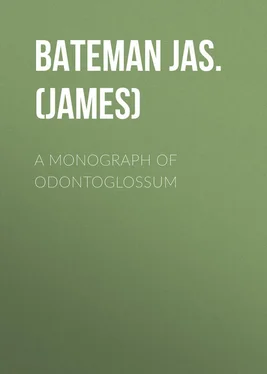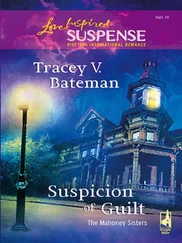Jas. (James) Bateman - A Monograph of Odontoglossum
Здесь есть возможность читать онлайн «Jas. (James) Bateman - A Monograph of Odontoglossum» — ознакомительный отрывок электронной книги совершенно бесплатно, а после прочтения отрывка купить полную версию. В некоторых случаях можно слушать аудио, скачать через торрент в формате fb2 и присутствует краткое содержание. Жанр: foreign_antique, foreign_prose, на английском языке. Описание произведения, (предисловие) а так же отзывы посетителей доступны на портале библиотеки ЛибКат.
- Название:A Monograph of Odontoglossum
- Автор:
- Жанр:
- Год:неизвестен
- ISBN:нет данных
- Рейтинг книги:5 / 5. Голосов: 1
-
Избранное:Добавить в избранное
- Отзывы:
-
Ваша оценка:
- 100
- 1
- 2
- 3
- 4
- 5
A Monograph of Odontoglossum: краткое содержание, описание и аннотация
Предлагаем к чтению аннотацию, описание, краткое содержание или предисловие (зависит от того, что написал сам автор книги «A Monograph of Odontoglossum»). Если вы не нашли необходимую информацию о книге — напишите в комментариях, мы постараемся отыскать её.
A Monograph of Odontoglossum — читать онлайн ознакомительный отрывок
Ниже представлен текст книги, разбитый по страницам. Система сохранения места последней прочитанной страницы, позволяет с удобством читать онлайн бесплатно книгу «A Monograph of Odontoglossum», без необходимости каждый раз заново искать на чём Вы остановились. Поставьте закладку, и сможете в любой момент перейти на страницу, на которой закончили чтение.
Интервал:
Закладка:
Odontoglossum nebulosum flowers at different seasons of the year, always sending up its scape at the same time as the young growth. It is of the easiest culture. 3 3 As most of the Odontoglossa require to be treated in the same way, I transcribe, from the 'Guide to Cool-Orchid Growing' (Reeve, 1864), the following instructions for the culture of the genus: – "They will all succeed perfectly in a low lean-to house facing the north, the mean temperature of which need not exceed 60°. They should stand on a shelf of slate or stone, near the glass, but should always be protected from the direct rays of the sun. Constant humidity should be maintained by damping the shelves and floors, but the plants themselves will only require water in moderation, and what is given to them should pass away freely, for if it stagnates, or if the compost in which they grow becomes sodden, the roots will immediately decay. A gentle evaporation is greatly assisted by placing layers of moss – to be kept damp of course – on the shelves whereon the plants stand. Odontoglossa cannot endure wooden blocks, but will thrive in a compost of which one-half consists of small broken potsherds, the remainder being a mixture of shredded sphagnum (dusted with fine sand) and fibrous peat. About one-third of the entire depth of the pots may be filled with this mixture, the other two-thirds containing nothing but large pieces of broken pots, so as to admit as much air as possible to the roots. The pots in which the plants are grown should stand on other pots (inverted) placed in saucers of water, in order to secure humidity and protect them from wood-lice. Nearly all the species flower during the winter or spring months, a circumstance that greatly enhances their value. Many, e. g. O. pulchellum , are deliciously fragrant, and the flowers of nearly all the species remain in perfection for weeks, whether left on the plants or cut for bouquets. In so vast a genus we shall, no doubt, meet with many idiosyncrasies, but nine-tenths of the species will flourish under the treatment indicated above, and which may be regarded as suitable to the majority of cool Orchids. Most Odontoglossa are, like the Masdevallias , very impatient of the knife, and cannot therefore be rapidly multiplied. They have also a peculiar aversion to fumigation by tobacco, which causes their leaves to fall off."
The figure was derived from a beautiful specimen that flowered last November in the collection of J. Day, Esq., of Tottenham, who grows this and many other Odontoglossa in high perfection.
Dissections. – 1. Lip, seen in front; 2. Ditto, seen sideways: both magnified .
Plate II.
ODONTOGLOSSUM URO-SKINNERI, Lindl
O. (Leucoglossum, Lindl .) pseudobulbis ovato-oblongis ancipitibus compressis guttulatis 1-2-phyllis, foliis oblongis acuminatis scapo multifloro simplici vel subpaniculato multo brevioribus, bracteis membranaceis cymbiformibus acuminatis ovario 3-plo brevioribus, petalis sepalisque subæqualibus late-ovatis acuminatis, labelli ungue bilamellato limbo cordato maculato acuminato undulato, columnæ alis ovatis deflexis.
Odontoglossum Uro-skinneri, Gardeners' Chronicle , vol. 1859, pp. 708, 724.
Habitat in Guatemala, prope Santa Catarina de los Altos, 5-6000 ft ., Skinner .
Pseudobulbs 3 or 4 inches long by nearly as many wide, much flattened, and very sharp at the edges, always powdered with minute brown dots, which do not appear until the second year . Leaves oblong, broad, and stiff, acuminate at their extremities, much shorter than the scape . Scape generally simple, but sometimes slightly panicled, about a yard high, and bearing from 10 to 20 agreeably scented Flowers. Bracts of a delicate texture, boat-shaped, scarcely more than one-third the length of the ovary . Sepals and Petals nearly equal, broadly ovate, about an inch long, of a green colour, covered with rich reddish-brown spots . Lip broad and spreading, heart-shaped, acuminate, and turned inwards at the apex, its disk white, but covered with round blue spots, which cease at the foot of the isthmus (claw), where two upright and nearly parallel lamellæ (plates) are stationed . Column furnished with ovate, decurved, round-headed wings .
This is a robust and stately plant, nearly allied to O. Bictoniense to which at one time Dr. Lindley was disposed to refer it, but far larger and handsomer in all its parts. Its broad pseudobulbs which become covered in their second year with a multitude of small reddish dots, its wide sepals and petals, the spotting of its lip, and its general resemblance to Zygopetalum Mackaii will, however, sufficiently distinguish it. Being found at a higher elevation than O. Bictoniense , it requires to be kept more cool, and as it affects dark and wet banks in its native wilds, it is better to place it in a north house where it can be more readily protected from the sun. Treated in this way it grows luxuriantly and flowers abundantly at Knypersley, whence the specimen figured in the Plate was derived. Its flowering season seems to vary, for while with me it is now (May) coming into bloom, about London November is the more usual month.
O. Uro-Skinneri was the latest discovery of my indefatigable friend Mr. Skinner (after whom it was named by Dr. Lindley), and who, though now settled in England, is as much devoted to his favourite tribe as when, while resident in Guatemala, he was wont to delight the Orchidists of Europe by the multitude of new and beautiful plants that he was constantly dispatching across the main.
Dissection. – 1. Side view of lip and column: magnified .
Plate III.
ODONTOGLOSSUM PHALÆNOPSIS, Rchb. fil
O. (Leucoglossum, Lindl .) pseudobulbis ovatis obtuse ancipitibus 1-2-phyllis, foliis linearibus acutissimis racemis bi- vel trifloris spithamæis longioribus, sepalis oblongo-ligulatis acutis, petalis latioribus obovatis obtusis; labelli ampli pandurati emarginati bilamelligeri disco velutino, columnæ alis abbreviatis membranaceis.
Odontoglossum phalænopsis, Rchb. fil. in Seemann Bonplandia , ii. 278; Pescatorea, Linden et Rchb. fil . ii. 44.
Miltonia Pulchella, Hort .
Habitat in N. Granada, prope Aspasica, alt. 5-6000 ft., Schlim .
Terrestrial . Pseudobulbs nearly two inches long, ovate, bearing one, or more frequently two, narrow linear, very acute Leaves, less than a foot long, and usually withered at the extremities . Raceme nodding, shorter than the leaves, furnished with a few small acute Bracts, and bearing two, or occasionally three, very large and handsome flowers, which, the markings of the lip excepted, are of a uniform white . Sepals oblong, sharp-pointed, about an inch long . Petals broader than the sepals, obtuse . Lip fiddle-shaped, its front portion deeply emarginate, spread out nearly flat, very broad, its side portions much smaller, rounded, and with two continuous upright lamellæ on its velvety disk; the lip has two large irregular pale-crimson blotches on its anterior portion, with concentric lines of the same colour on its lower portion, with a small patch of yellow on either side the isthmus (i.e. point of junction between the upper and lower divisions of the lip ). Column short, with membranous wings much abbreviated .
This most charming Odontoglossum was discovered in the year 1850 by M. Schlim at that time engaged in exploring the higher regions of New Granada in the service of M. Linden to whose well-known horticultural establishment at Brussels he had the honour of introducing it. The species was seen in flower for the first time in the year 1856 when it appeared at some Horticultural Exhibitions both on the Continent and in London and, as may readily be conceived, attracted universal admiration. Since that time its lovely blossoms have been rarely produced, owing no doubt to its cultivation having been imperfectly understood. It has however, I believe, bloomed occasionally in the collection of the Lord Chancellor of Ireland, and more recently in that of E. M‘Morland, Esq., of Haverstock Hill, with whom it thrives amazingly, and to whose kindness I am indebted for the opportunity of figuring it. In its native country it is found in a mild climate growing on the ground, or upon rocks in moist and shady situations, and by simply imitating these conditions Mr. M‘Morland cultivates it with the most perfect success. His plants are kept in pots, with living moss on the surface, and their base resting in pans of water the evaporation from which cannot fail to be highly beneficial. The temperature of the house in which they are grown is that of an ordinary greenhouse, but the air is always humid, and water is freely given because, in consequence of the open potting , it can pass as freely away. The plants seem to grow and flower almost all the year round, though their proper and principal flowering-season is in May and June.
Читать дальшеИнтервал:
Закладка:
Похожие книги на «A Monograph of Odontoglossum»
Представляем Вашему вниманию похожие книги на «A Monograph of Odontoglossum» списком для выбора. Мы отобрали схожую по названию и смыслу литературу в надежде предоставить читателям больше вариантов отыскать новые, интересные, ещё непрочитанные произведения.
Обсуждение, отзывы о книге «A Monograph of Odontoglossum» и просто собственные мнения читателей. Оставьте ваши комментарии, напишите, что Вы думаете о произведении, его смысле или главных героях. Укажите что конкретно понравилось, а что нет, и почему Вы так считаете.












